Cologne
by Verena Kämpken
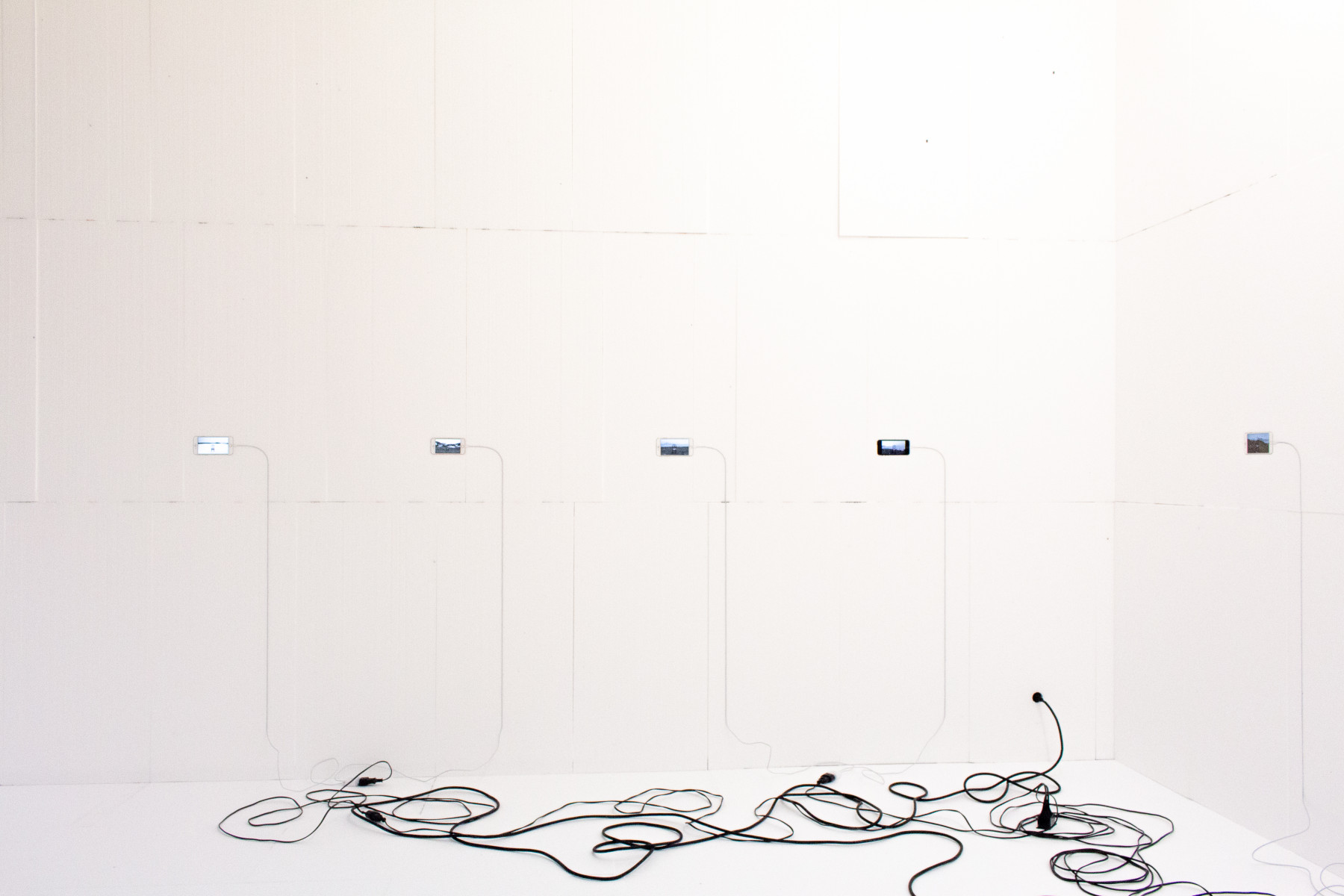
Esteban Sánchez, Auf den Feldern der Zeit, 2024, exhibition view, Matjö, Cologne. Mixed-media/audio installation. © Esteban Sánchez, courtesy of the artist
While the setting of a white room – ergo, the white cube – should come as no surprise in any gallery experience, it should be particularly anticipated in an exhibition dealing with Antarctica. Esteban Sánchez's installation at the small Cologne gallery space Matjö is no exception. Through the gallery window, one sees a white room dotted with tiny grey and black rectangles. The walls and floor are covered with white polystyrene panels, and the little rectangles are smartphones, seamlessly embedded in the material by sanding. All the phones are connected to electricity with visible charging cables hanging onto the floor. Their screens play videos in loops, each centred on the back of the same empty chair, facing a different Antarctic landscape.
The empty chair, like the white room, echoes a rather classic motif in art history. The typical symbolism of the chair as 'present absence' can be taken quite literally in Sánchez's work In the Fields of Time (Auf den Feldern der Zeit). Due to a lung defect he was born with, the artist had to turn down an invitation to a residency in Antarctica. Instead, he directed his artistic vision from afar, giving precise technical and poetic specifications and instructions. [1] This process, as well as the placement of the chair, implies an extended commitment to both the artist's absence in and his artistic engagement with Antarctica. The chair as a recurring theme in the installation is an invitation to reflect on human absence and presence in this landscape.
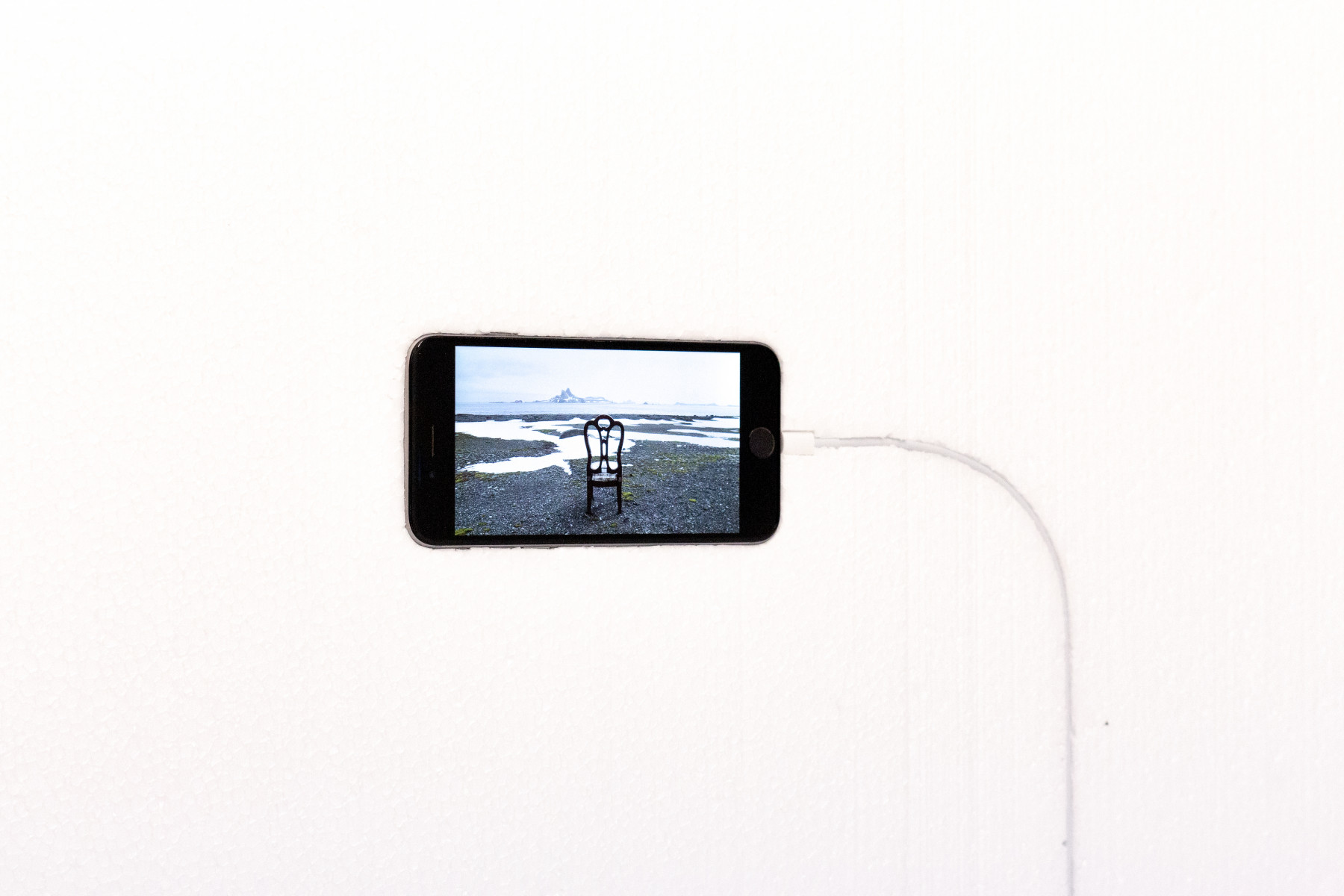
Esteban Sánchez, Auf den Feldern der Zeit, 2024, detail, Matjö, Cologne. Mixed-media/audio installation. © Esteban Sánchez, courtesy of the artist
Given the adversities that had to be overcome to reach and survive Earth's southernmost continent, the first rush of Antarctic exploration at the turn of the 20th century is remembered as the 'heroic age'. In this sense, Antarctic travel was characterised by the technological transcendence of physical boundaries. As the only continent not tied to humans through Indigeneity, it became subject to colonial notions of a truer kind of 'no man's land' to be 'discovered', there for the taking. Historically, Antarctic narratives have been overrun by the image of the heroic male conqueror. Today, despite being better equipped than ever to face Antarctic conditions, ventures into the territory are much more conflicted undertakings, requiring complicated considerations of human presence on site. In a sort of 'post-heroic' era, contemporary relations with Antarctica are concerned with erasing the traces of an imperial and colonial past. [2] So far, the international Antarctic treaty system regulates respect for territorial non-claimancy and prohibits any extractive activity, at least until 2048. [3] By not appropriating the land and its raw materials, Antarctica remains an untapped source of primitive accumulation that some actors are waiting to exploit. [4]
Against this historical backdrop, Esteban Sánchez's choice to use an antique chair in the video recordings, while perhaps influenced by the limited requisites at hand, appears as a visual reference to the heroic age of Antarctic exploration. As "the masculine body lost its centrality to this endeavour", to borrow scientific researcher Elena Glasberg's words, the empty chair as a stand-in for the artist’s absence can be read as a memorial to this narrative sense of loss and a marker of the 'loss of empire' implied by the treaty. [5]
Not only are previous notions of heroism being challenged, but we are also forced to realise how easily fragile ecosystems such as Antarctica’s can be contaminated and severely damaged by human presence. The area has become a hypermediated, highly monitored territory, and Antarctic ice, which accounts for almost 90% of the world’s ice, has taken on a central role in telling the story of climate change. [6] The ice literally tells stories of planetary time, by "archiving air and stardust and microplastics" and providing evidence of different temporal dimensions of human activity in its layers. [7]
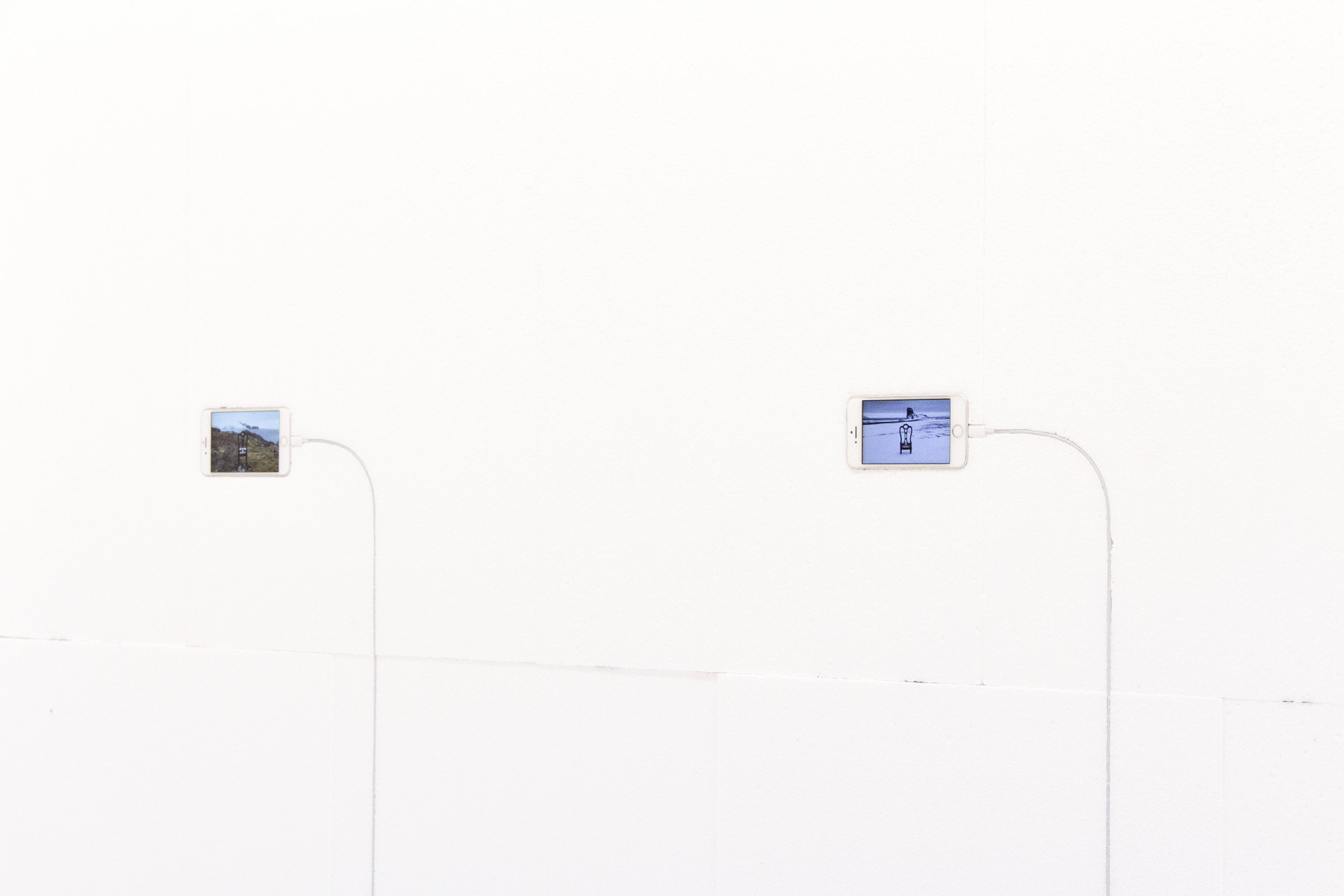
Esteban Sánchez, Auf den Feldern der Zeit, 2024, detail, Matjö, Cologne. Mixed-media/audio installation. © Esteban Sánchez, courtesy of the artist
Figuratively, the ice can represent planetary precarity, as the weather effects of climate change threaten to melt it at an alarming rate, foreshadowing future scenarios of flooded and drowned populations. Images such as the ice-free green and grey landscapes in Sánchez’s videos evoke surprise, disappointment or even panic: shouldn’t everything be covered in ice? Instead of humans migrating across the planet, the ice itself is now migrating, and the poles are becoming more like the rest of the globe. Climate change is having an increasing impact on how humans relate to Antarctica. [8]
Feminist political ecologist and professor Farhana Sultana has pointed out how "[c]limate coloniality reproduces the hauntings of colonialism and imperialism through the effects of climate impacts in the post-colony." [9] Colonial understandings of land relations need to be transcended. Instead, we need ways of interacting, feeling, knowing and listening that go beyond human impact on the territory to consider the role and influence of Antarctica itself on human existence, as a relationship of mutual becoming. [10]
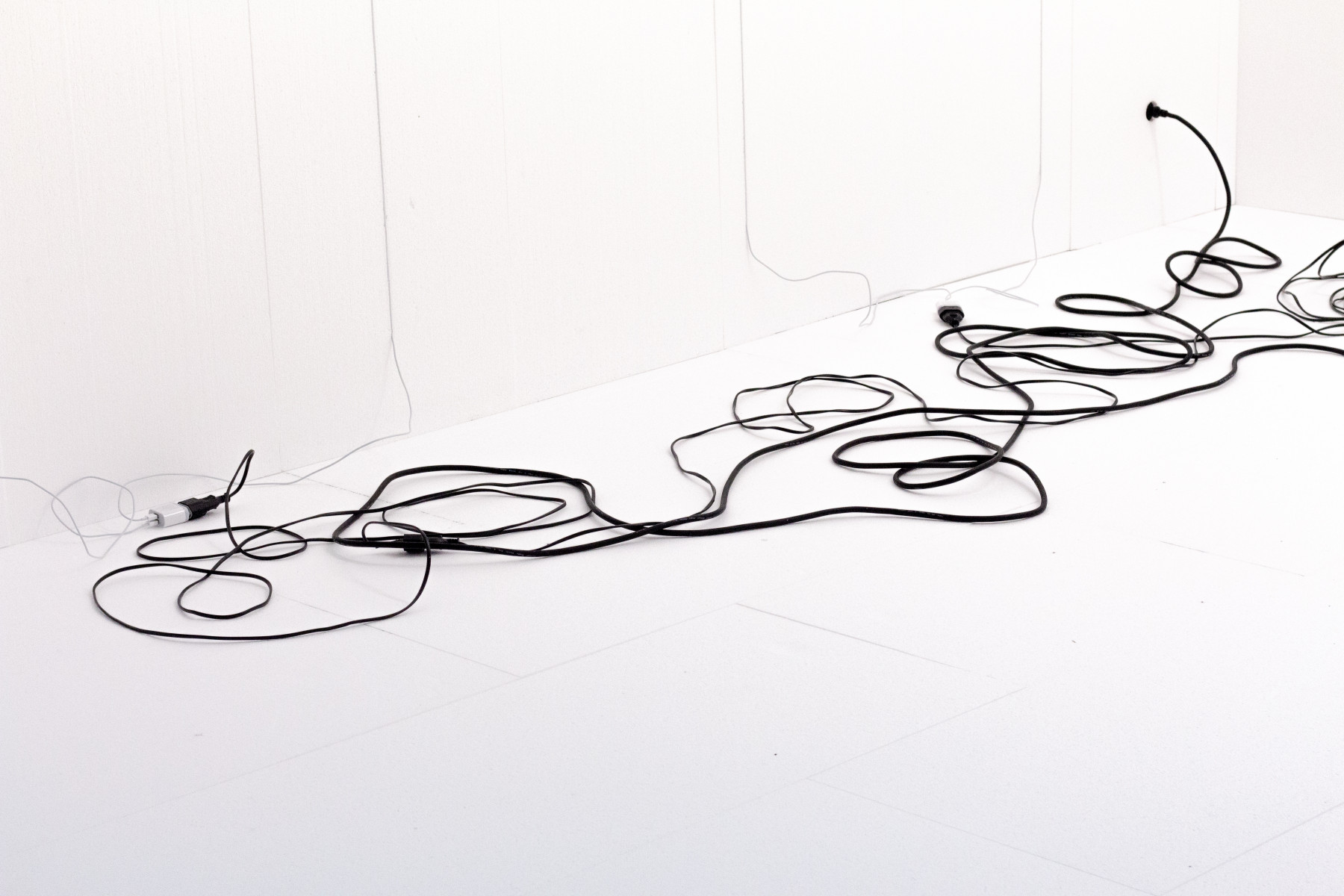
Esteban Sánchez, Auf den Feldern der Zeit, 2024, detail, Matjö, Cologne. Mixed-media/audio installation. © Esteban Sánchez, courtesy of the artist
Sánchez's decision to title the work 'In the Fields of Time' may be due to associations with the archival function of Antarctic ice, the Cold War battleground for primitive accumulation that is currently obscured by the institutionalisation of Antarctic relations by nations, as well as the image war that seeks to emphasise the urgency of finding political solutions to climate change. By eliciting common, seemingly reserved, uninspired themes of art history and/or the Antarctic imaginary in his media sculpture, such as the whiteness of the exhibition space and the empty chair, the artist reiterates established ways of looking at and experiencing the Antarctic landscape [11]. Like the white cube, Antarctica functions as a stage for the performance of human ways of experiencing, knowing and being.
Sánchez has taken care to add several elements that give the white cube a sensory twist. The polystyrene panels, a common packaging material used in everyday life, emphasise the spatiality of the exhibition space and theme, giving the impression of a padded cell, also known as a seclusion room or, in more contemporary psychiatric terms, as a crisis intervention room. It is a room ostensibly designed to prevent a person 'in crisis' from physically harming themselves or others. However, this padded white cube cannot successfully shield its visitors from the environment – or vice versa.
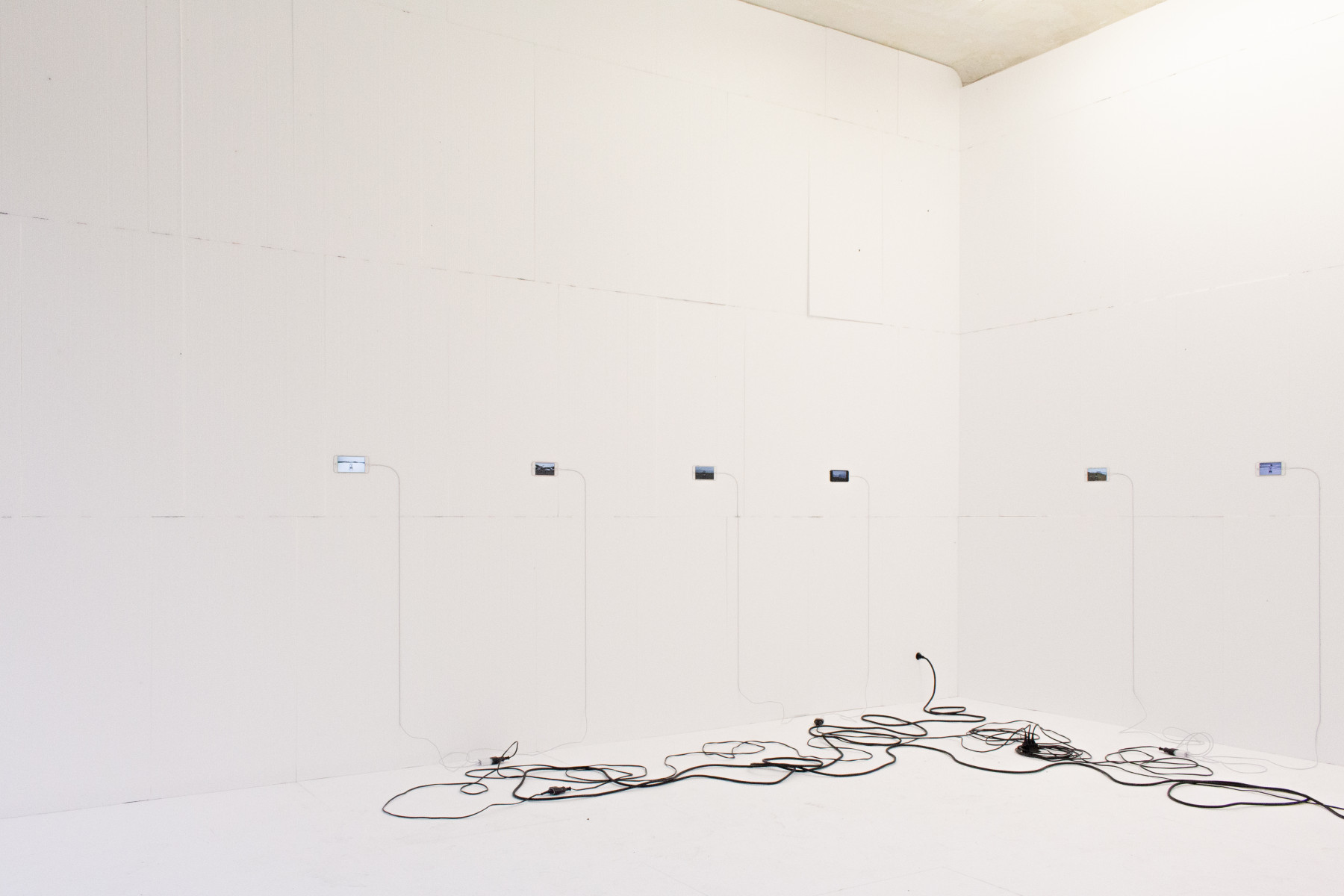
Esteban Sánchez, Auf den Feldern der Zeit, 2024, exhibition view, Matjö, Cologne. Mixed-media/audio installation. © Esteban Sánchez, courtesy of the artist
The smartphones play recordings of gurgling sounds and the humming of engines that were sonic backdrops to the landscapes depicted. The cables that supply the phones with a constant flow of energy are not hidden in the walls as usual, but visibly graze the white surfaces. By repurposing polystyrene as a floor, its ephemerality comes to the fore: the material crunches under each visitor's feet, almost like the solid Antarctic snow that the artist may have imagined sounding like under his steps. Over the course of the exhibition, the floor wears away, pressed into the shape of footprints. Tiny shreds and pellets are dislodged by the friction of visitors' movements, entering material flows that extend far beyond the gallery space. As recently as 2020, it was reported that polystyrene had entered the Antarctic food chain, having been found in the stomach of a collembolan, a tiny soil-dwelling organism. [12]
Sánchez's composition of polystyrene, phones and cables juxtaposes the material realities of Antarctic ice with the material realities of our everyday modes of connection and consumption. In doing so, he subtly illustrates how everything and all things are connected through constant processual flows of materiality.
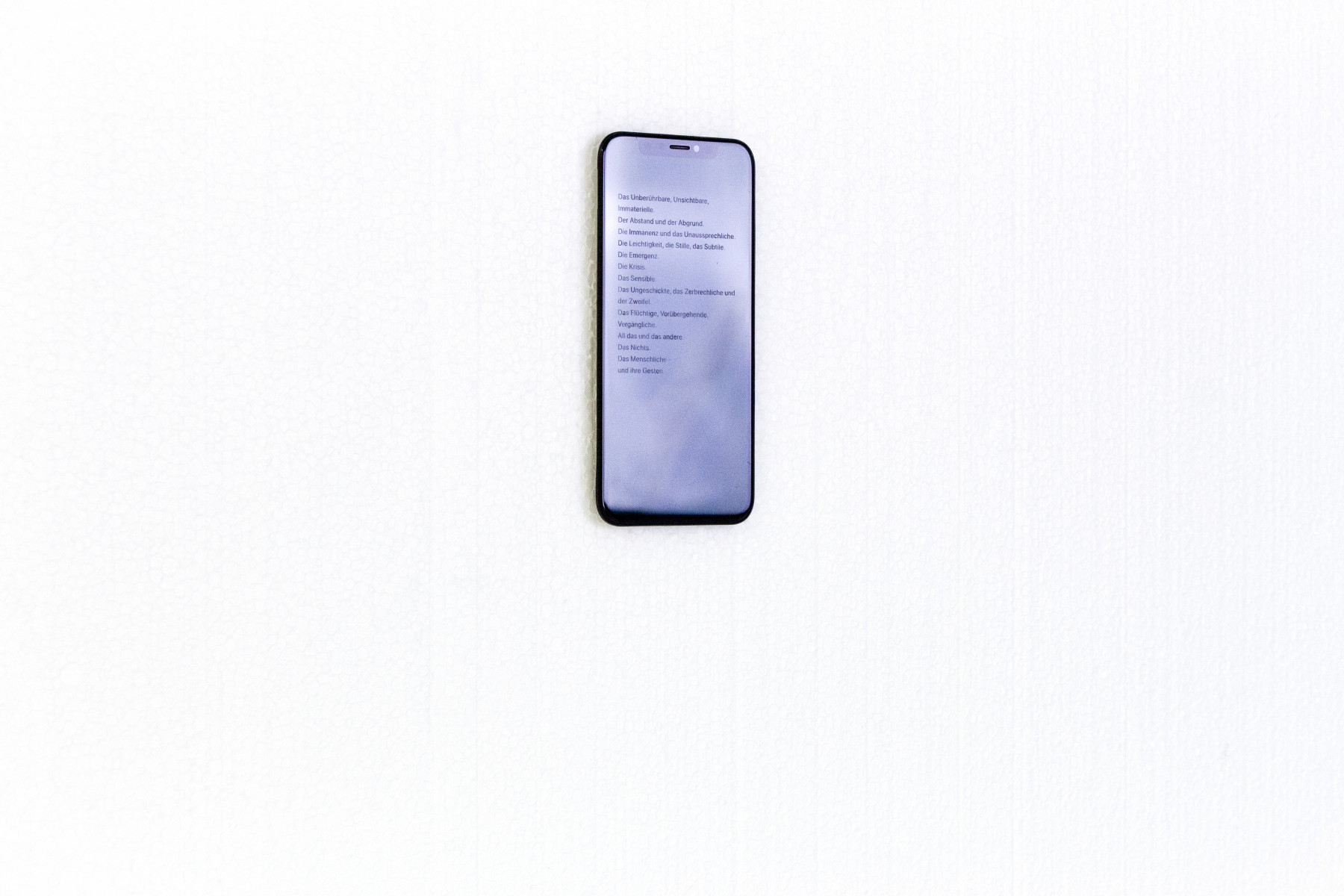
Esteban Sánchez, Auf den Feldern der Zeit, 2024, detail, Matjö, Cologne. Mixed-media/audio installation. © Esteban Sánchez, courtesy of the artist
Lingering on the image of a psychiatric crisis intervention room, Sánchez’s empty chair takes on the air of a psychodramatic setting popular in Gestalt therapy. The 'empty chair technique' is used to create space for dialogue by representing an absent or imaginary partner with whom a (rehearsed) conversation could be crucial to self-awareness or, at best, healing. The chair doesn't turn its back on Antarctica, but faces it, as if the landscape itself were inviting the viewer to sit down and join the dialogue. Perhaps then we might finally hear it whispering, over and over again, "go away".
The fact that Esteban Sánchez's illness forced him to stay away from Antarctica makes his work all the more meaningful. Contrary to a more conscious decision not to travel, being constrained by the fragility of his 'sick' body creates a kind of reciprocity with a fragile planet.
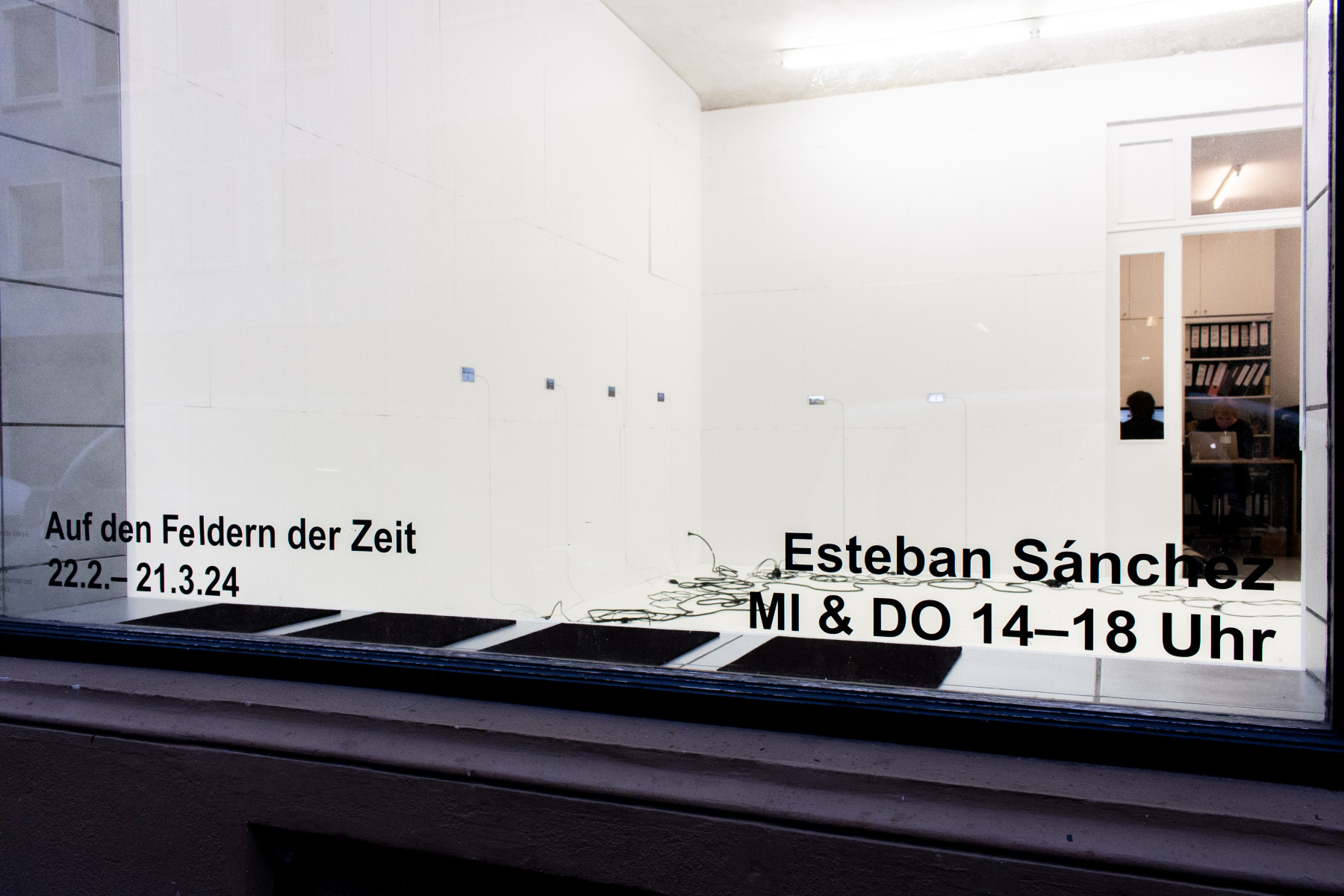
Esteban Sánchez, Auf den Feldern der Zeit, 2024, exhibition view, Matjö, Cologne. Mixed-media/audio installation. © Esteban Sánchez, courtesy of the artist
[1] Michael Stockhausen, Esteban Sánchez – Auf den Feldern der Zeit, 2024, matjoe.de.
[2] Elena Glasberg, Antarctica as Cultural Critique, 2012, palgrave macmillan, pp. xi-xxiii.
[3a] UNLESS, Mission: Antarctic Resolution, 2024.
[4] Marx used the term ‘primitive accumulation’ to describe origins of capital through the creation and extraction of value. Examples are forced or unpaid labor and the appropriation of land and resources, which is why this term is helpful to think about systemic connections between capitalism, colonialism and climate change.
[5] Glasberg, 2012, p. xxiii.
[6] UNLESS, Mission: Antarctic Resolution, 2024.
[7] Stephanie Krzywonos, Antarctica the Women, 2023, emergence magazine.
[8] Glasberg, 2012, p. 132.
[9] Farhana Sultana, The unbearable heaviness of climate coloniality, 2020, Political Geography, volume 99.
[10] Elizabeth Rush, Glacial longings, 2024, emergence magazine.
[11] Glasberg, 2012, p. xix.
[12] Elisa Bergami, Emilia Rota, Tancredi Caruso, Giovanni Birarda, Lisa Vacari and Ilaria Corsi, Plastics everywhere: first evidence of polystyrene fragments inside the common Antarctic collembolan Cryptopygus antarcticus, 2020, Biology Letters.
Auf den Feldern der Zeit
Esteban Sánchez
22/02/2024 – 21/03/2024
Matjö – Raum für Kunst
Mathiasstraße 15
50676 Cologne